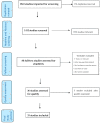Lanthanum Carbonate Opacities-A Systematic Review
- PMID: 35204554
- PMCID: PMC8871341
- DOI: 10.3390/diagnostics12020464
Lanthanum Carbonate Opacities-A Systematic Review
Abstract
Background: Lanthanum carbonate is a phosphate binder used in advanced kidney disease. Its radiopaque appearance has been described in many case studies and case series. Misinterpretation of this phenomenon leads to unnecessary diagnostic tests and procedures. The objectives of this study were to summarize the literature on lanthanum carbonate opacities and present a visual overview.
Methods: A systematic search was conducted using MEDLINE, Embase, and Web of Science. We included all types of studies, including case reports/studies, describing radiological findings of lanthanum carbonate opacities in patients with chronic kidney disease. No filter for time was set.
Results: A total of 36 articles were eligible for data extraction, and 33 articles were included in the narrative synthesis. Lanthanum carbonate opacities were most commonly reported in the intestines (26 studies, 73%), stomach (8 studies, 21%), and the aerodigestive tract (2 studies, 6%). The opacities in the intestine were most frequently described as multiple, scattered radiopaque densities, compared with the aerodigestive tract, where the opacities were described as a single, round foreign body. Suspicion of contrast medium or foreign bodies was the most common differential diagnosis. LC opacities in patients with CKD are commonly misinterpreted as foreign bodies or suspect contrast media.
Conclusions: CKD patients treated with LC may have opacities throughout the digestive tract that can vary in appearance. Stopping LC treatment or changing to an alternative phosphate binder prior to planned image studies can avoid diagnostic confusion. If this is not an option, knowledge of the presentation of LC opacities is important.
Keywords: CKD; image studies; lanthanum carbonate.
Conflict of interest statement
The authors declare no conflict of interest.
Figures




References
Publication types
LinkOut - more resources
Full Text Sources

